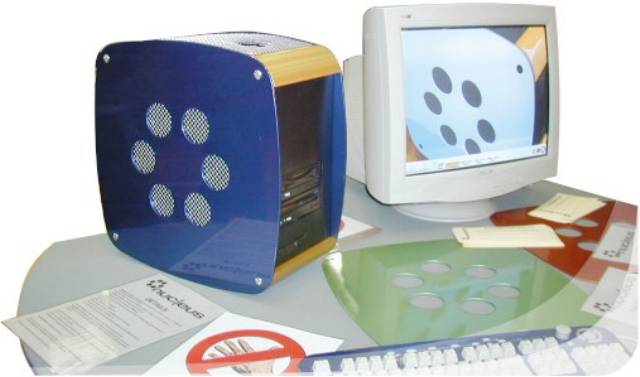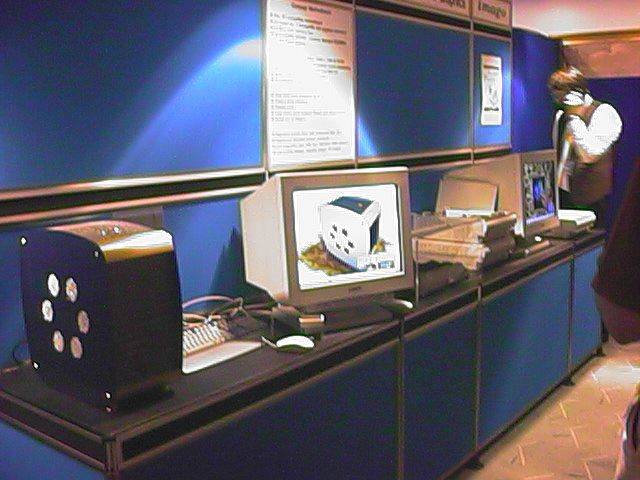
[After Acorn] [Companies ]
Cerilica announced the Nucleus in 1999:
The Cerilica Nucleus was intended from the outset to cater for the professional and semi-professional design and publishing market. It is not a product that is aimed at satisfying users of any particular platform, but rather to provide a quick, easy and efficient method to complete a set design and publishing task.
With so many computer systems attempting to attract a complete spectrum of users, it is an intentionally refreshing change to enable a system to be focused once more at a specific area — one that it will be able to have great success in. All of the energy channelled into this product will be done so to aid the user whilst producing or manipulating graphics and then committing them to ink or screen.
Nucleus will remain a low volume product by its very nature and Cerilica intends to take complete advantage of this fantastic situation. A whole range of options will be made available which would be otherwise unfeasible on mass production lines, from the case colour, finish and even size, through to individual software and hardware setups that will cater exactly for the specific customer as soon as it's unpackaged.
The case design and fabrication is one of the most unique of any computer. Physcially large in order to house as much equipment as could reasonably be required and agressively styled, Nucleus was not designed to be hidden out of view. With its beautifully laser cut 4mm aluminium side plates, gloriously anodised corner extrusions and sturdy metal chassis, plastic is taboo word. Even the flamboyant large red starter button is machined out of solid aluminium. All this is possible by not being tempted to save pennies at every opportunity. Nucleus is over-engineered on purpose. It is designed to last.
The prototype was completed and shown at the 2000 Wakefield RISC OS show to much acclaim. Although it was not quite finished, it contained one of the five prototype Imago boards. Unfortunately delays in completing the Millipede Imago motherboard put the project on hold and it was eventually abandoned.
In 2003 the prototype case was auctioned on ebay.
None

Cerilica Nucleus (from Cerilica Website)

Cerilica Nucleus at RISC OS 2000 show
Specification:
The following specification is taken from the Cerilica website in 1999/2000:
The following specification is not set in stone, but is an accurate description of what the Nucleus is likely to be supplied with in basic form. Please see the Nucleus Options page for details of just how far Cerilica is willing to ensure that the product you purchase is right for you.
| Case | Full metal case - 4mm aluminium laser-profiled side panels, aluminium corner extrusions and steel internal dual chassis |
| Approximate dimensions: 430mm x 430mm x 200mm | |
| Unique dual internal chassis allows for quich access to either motherboard and expansion podule cards or drives and power supply | |
| 3 5¼" drive bays (for CDs, DVDs removable drives etc) | |
| 6 3½" drive bays (for floppy drives, hard discs, ec.) | |
| 3 further hard discs may be fitted internally | |
| 4 EASI podule expansion slots | |
| 230W or 300W power AT supply (with switched monitor power output) | |
| Integrated screwdriver and allen key toolkit | |
| Hardware | Millipede Imago motherboard (developed by people who create professional studio graphics hardware such as the equipment that drives the hit international quiz show Who wants to be a Millionaire™ and Stars in their Eyes |
| Intel StrongARM RISC processor with processor upgrade connector | |
| 128MB standard PC SDRAM (up to 512MB may be fitted) running at aminimum of 100MHz | |
| 16MB flash memory | |
| Video resolution up to 2048 x1536 at 72Hz in 24-bit (16+ million) colours - monitor dependant | |
| 100 Base-TX ethernet | |
| Dual EIDE interface allowing four EIDE drives to be driven as standard with planned ultra DMA mode running at 32MB/s | |
| Serial port up to 460KB/s | |
| Dual USB port | |
| PS/2 mouse | |
| PS/2 Cerilica Multi-Media Keyboard (includes music buttons, rotary volume/Vantage object control, hotkeys) | |
| Game port with joystick and MIDI I/O | |
| Enhanced SoundBlaster™ compatible sound processing | |
| Audio/video expansion bus with enhanced data rate | |
| Additional decoded podule connector | |
| Standard processor expansion connector for PC card (future potential software driver dependant) | |
| Software enhancing hardware | At the heart of the Imago lies an FPGA chip which may be programmed after manufacture allowing key software components to be programmed into hardware providing potentially great increases in performance - Vantage being the first application to benefit |
| Operating System | RISC OS 4 (actively being developed by PACE |
| Frugal and may be completely placed within Flash memory making it undeletable and never necessary to reinstall as well as consuming virtually no memory | |
| Software loadable upgrades | |
| Highly efficient user interface with minimal intrusion on the design and publishing process | |
| May be networked to PCs and Macs | |
| Discs from PCs, Macs and Linux may be read and written | |
| Internet access packages available (certain optional components at cost) | |
| Screen colour and resolutions may be altered quickly and easily without having to reboot | |
| Inbuilt Postscript output | |
| Direct enhanced printing to selected printer models | |
| System-wide on-screen font anti-aliasing for accurate and sharpest possible display down to very small font sizes | |
| Peripherals | 3½" floppy drive |
| CD drive (music output can be directly controlled by Multi-Media Keyboard | |
| Large EIDE fast access hard disc | |
| Software | Basic RISC OS software bundle includes file editors, bitmap graphic import/export, pixel editor, vector graphic editor |
| Cerilica will actively be seeking licences to bundle further software as standard, including a range of excellent freeware graphics utilities |